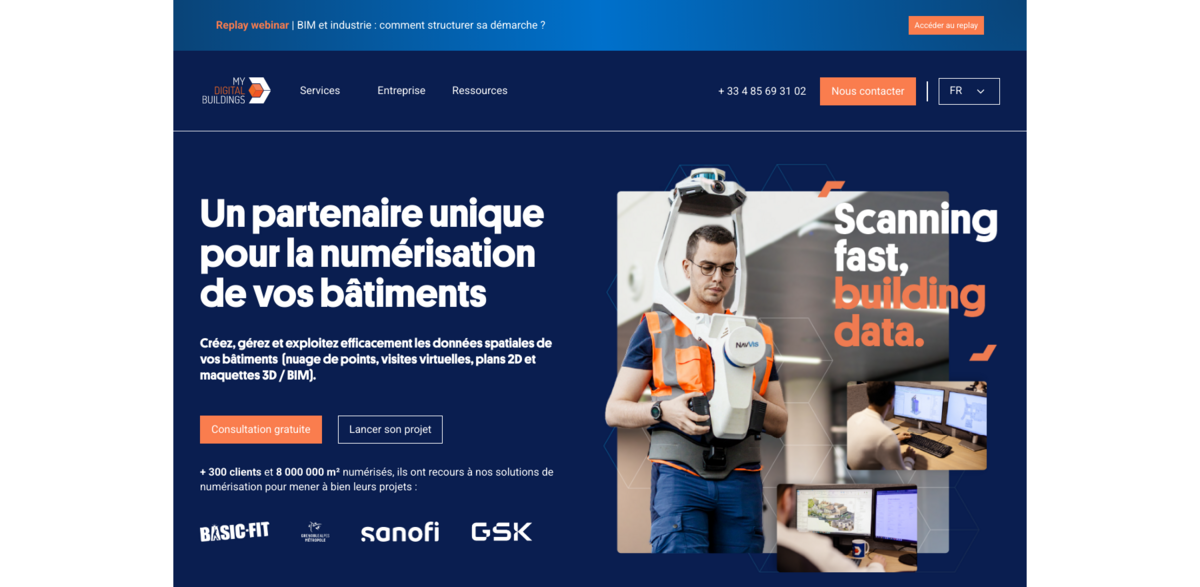What Is the Project About?
This project revolves around the digitization of buildings through advanced spatial data techniques. It’s all about unlocking the potential of spatial data from your buildings by creating digital twins—think point clouds, virtual tours, 2D plans, and 3D/BIM models. These digital representations allow for a better understanding, management, and transformation of real estate assets. The process relies heavily on 3D scanning technology, capturing precise spatial data that’s then processed into usable formats for various professional needs. The goal? To centralize, manage, and visualize spatial data on a secure platform, making it accessible and actionable for industries like pharmaceuticals, manufacturing, construction, and more.
Main Benefits and Key Figures
Why does this matter? Because digitizing buildings opens up a whole new world of possibilities. Here are some key facts and figures that highlight the impact:
- Over 300 clients trust these digitization solutions.
- More than 8,000,000 m² of buildings have been digitized.
- Rapid and standardized 3D surveys conducted across Europe.
- Multiple deliverables: point clouds, 3D models, 2D plans, virtual tours.
- A network of local agencies ensures responsiveness and standardization.
Understanding Spatial Data and Digital Twins
Spatial data is basically all the raw info related to space—images, points, and more—whose position is precisely mapped in a coordinate system. When this data is assembled and interpreted, it forms the backbone of digital twins. These twins aren’t just fancy models; they’re detailed digital replicas of buildings that serve different technical and professional purposes. Whether it’s a point cloud, a virtual tour, or a BIM model, each representation offers unique insights and functionalities tailored to specific needs.
The Digitization Process: From Scan to BIM
The journey starts with understanding the client’s needs and choosing the right deliverables. Then comes selecting the appropriate 3D scanning solutions based on the building’s specifics. After studying existing plans and defining scanning strategies, the actual on-site scanning takes place. Finally, post-processing transforms raw data into usable formats like .rcp, .e57, or .xyz files. The “scan to BIM” methodology ensures that the digital models have centimeter-level precision, making them incredibly reliable for CAD and BIM applications.
Deliverables and Services Offered
The project offers a comprehensive suite of services designed to cover every aspect of building digitization:
- 3D Scan: Fast, standardized surveys regardless of location.
- 2D Plans: Detailed plans drawn from 3D point clouds.
- 3D Models / BIM: High-precision models created through scan to BIM.
- Virtual Tours: Immersive, interactive tours for remote exploration.
All these deliverables are accessible through a centralized platform that ensures secure data management and visualization, making it easier to track projects and request quotes online.
Project Impact on Sustainable Development Goals (SDGs)
- SDG 9: Industry, Innovation, and Infrastructure – by promoting advanced digital infrastructure for building management.
- SDG 11: Sustainable Cities and Communities – through better asset management and urban planning.
- SDG 12: Responsible Consumption and Production – by optimizing resource use via precise digital models.
- SDG 13: Climate Action – enabling energy-efficient building management and retrofitting.
Additional Resources and Support
To support users in their digitization journey, a rich resource library is available, featuring articles, client cases, and technical guides. For example, there’s a white paper explaining different Levels of Detail (LOD) with clear illustrations, and an article that clarifies why the term “digital twin” is preferred over “digital twin of a building.” These resources help demystify the technology and provide practical insights for managing digital assets effectively. Plus, a network of reactive agencies across Europe ensures local support and consistent project quality.





















